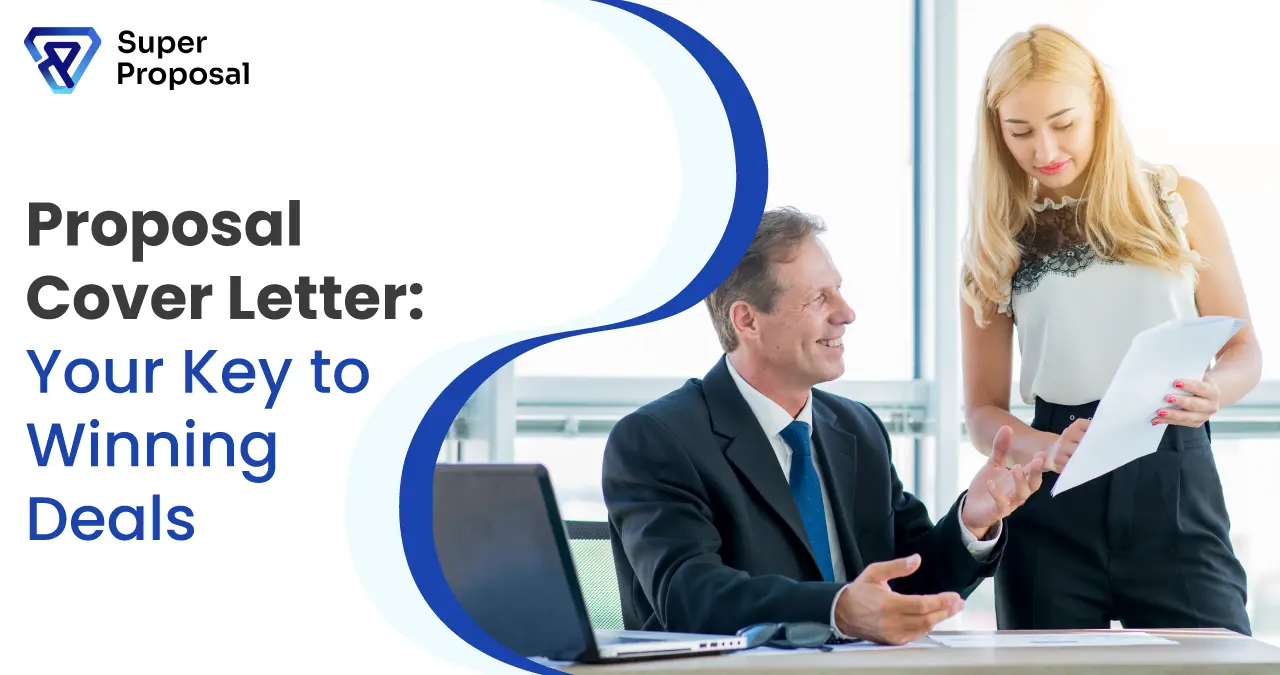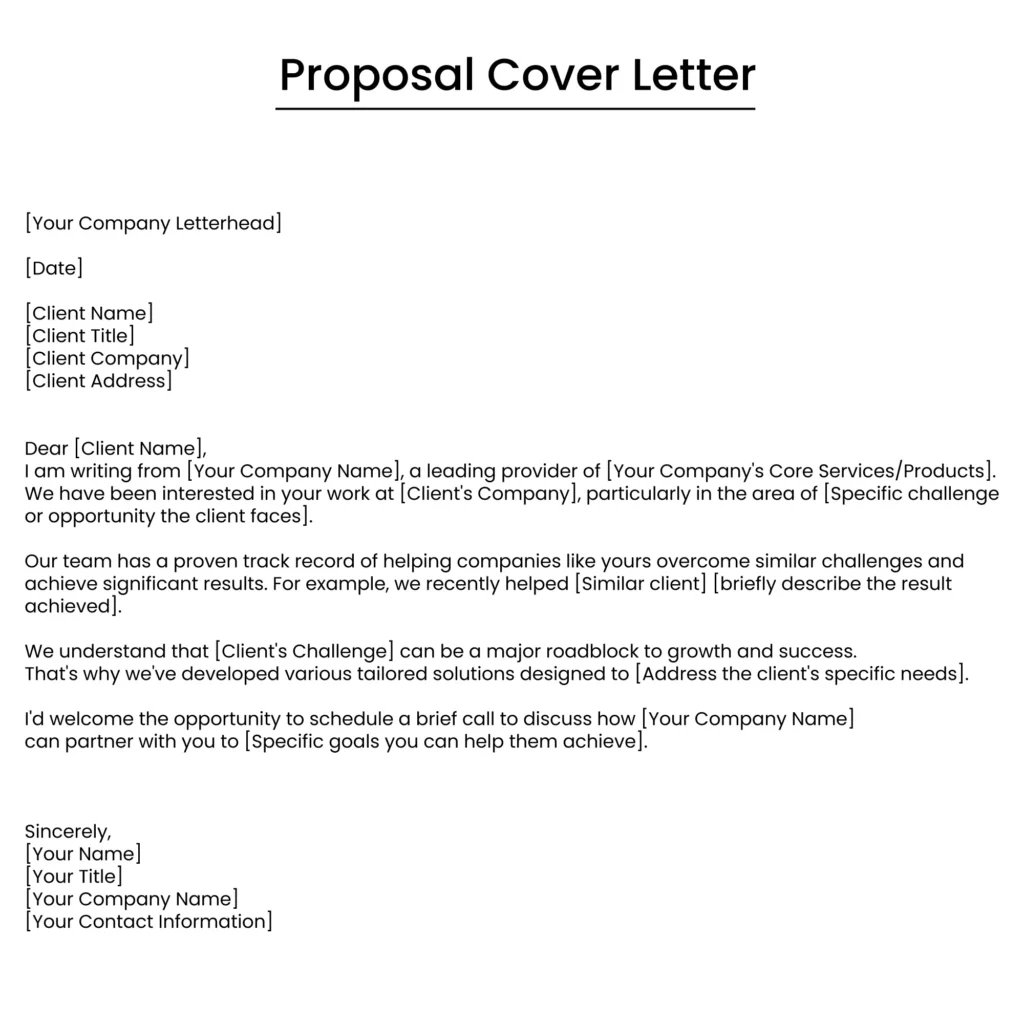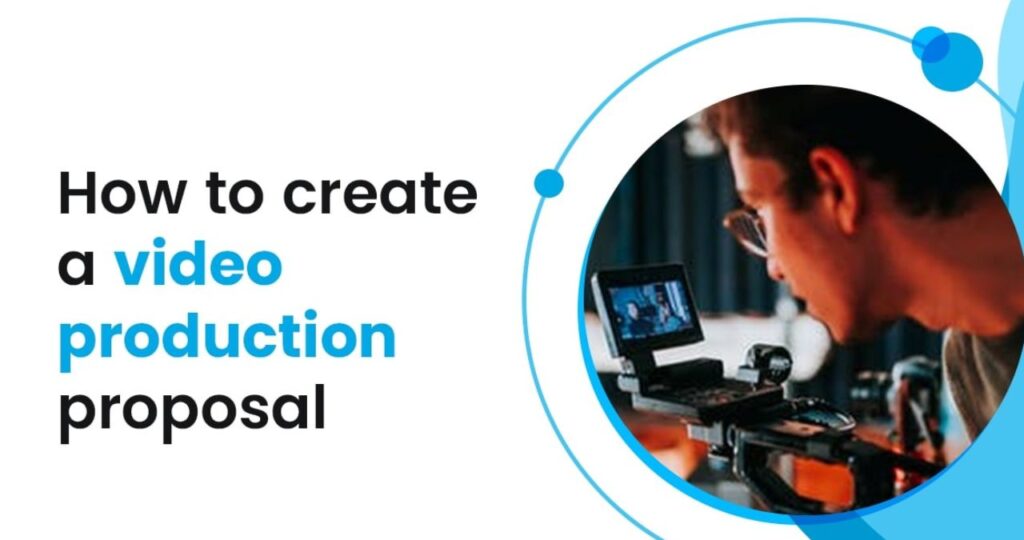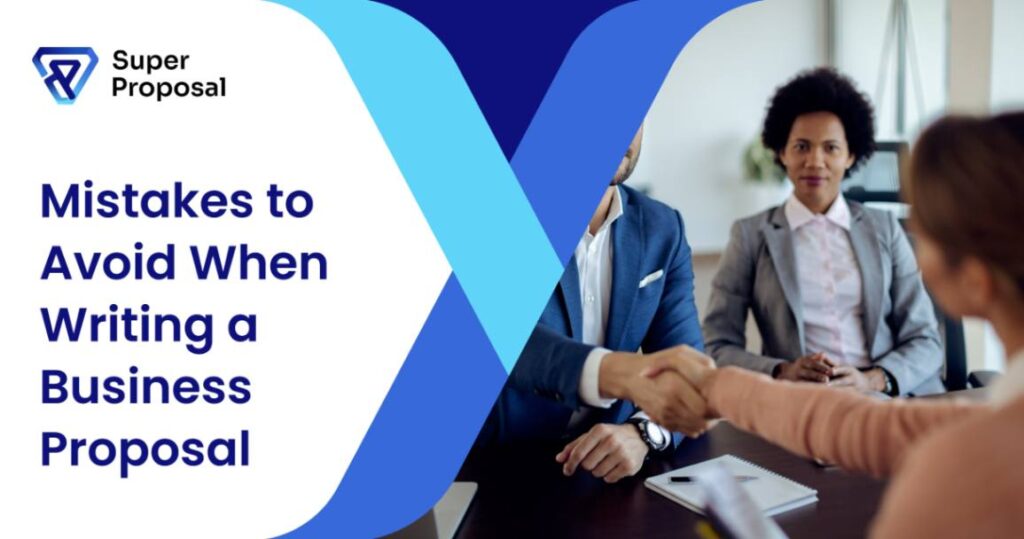How to Write a Winning Proposal Cover Letter (5 Examples)
AUG 23, 2024 | LAST UPDATED ON AUG 23, 2024 BY ANGELICA NAIDU

A strong proposal cover letter is like a firm handshake when you meet someone for the first time. It sets the tone for the entire interaction. In the business world, your proposal cover letter serves as an introduction to potential clients to intrigue and entice the reader or the client to continue reading the whole proposal.
Fortunately, to ease things up, there are proposal creation tools and software specially designed to craft an eye-catching proposal as well as the cover letter. One such software is Super Proposal.
Keep reading to learn what to include in your cover letter to make it stand out, and secrets for impressive introductions.
What is a Proposal Cover Letter?
A proposal cover letter is a short document that introduces your full proposal. It serves as an abstract, highlighting the important points of your solution and unique selling propositions.
That being said, make it a short, quick, one-page teaser. Who likes reading a boring proposal, anyway?
You will usually find this one-pager right after the title page of your proposal. It should not repeat all the minute details. Instead, it should summarize your unique selling points in an informal way, making it easy for the client to understand.
Both the cover letter and the executive summary fundamentally carry the same underlying message. Still, each serves different purposes: the former being more of an introduction cum elevator pitch aimed at securing a client’s attention, and the latter highlighting the methodology and expected outcomes of the whole proposal.
Table of Contents
ToggleWhat Should You Include in a Proposal Cover Letter?
Your proposal, much like an effective cover letter, should begin with a unique offer or positioning statement. It is important to clearly establish from the beginning why your team is the ideal choice to address the client’s needs. Let’s break down how to build a winning cover letter:
Formal Greeting
Begin by professionally addressing the client. A personalized greeting demonstrates respect and attention to detail.
Bad example: “To whomsoever to may concern” (Impersonal and outdated)
Good example: “Dear Mr. Johnson” (Shows you have done your research)
Concise Summary
Briefly and clearly explain your proposal’s problem and summarize your proposed solution. Highlight your unique value proposition and how it aligns with the client’s objectives.
Bad example: “Our proposal provides several solutions for your customer service challenges.” (It is vague and doesn’t provide any value)
Good example: “Understanding that XYZ company aims to focus on customer service, we have a unique automated chatbot solution which can reduce your response time by 50%.” (This is concise and impactful)
Contact Information
Ensure your name, title, company name, email address, and other relevant information are properly displayed. This makes it easier for the client to communicate with you.
Visual Elements
Consider incorporating elements like a company logo or graphics related to your proposal to enhance the document’s visual appeal. However, clarity should be important, and the visual complements shouldn’t distract the clients from the content.
Personalization
Outline how your unique skills, resources, and experience make you the ideal partner for the project. Show clearly what separates you from the competition and how you will be able to help the clients meet their needs.
Bad example: “We have experience working with various clients across different industries.” (This is too generic)
Good example: “With our team’s 10+ years of experience in the ABC industry, we can provide tailored solutions for you.” (This is specific and highlights your expertise)
References
If you have relevant past projects or client testimonials highlighting your capabilities and success, mention them. This adds credibility to all your claims and reassures the client of your competence.
How to Write a Winning Proposal Cover Letter
A proposal cover letter is your time to shine, so let’s understand how you can write a winning proposal cover letter:
Step 1: Read the RFP Cover to Cover
Before putting pen to paper (or, for that matter, finger to keyboard), immerse yourself in the Request for Proposal (RFP). This is about ticking the boxes and understanding the nuances of the client’s needs. Ask yourself all these questions:
- What are their pain points?
- What language do they use to describe their challenges?
- Are there recurring issues or priorities that need to be addressed immediately?
For instance, when reviewing an RFP related to software or applications, look for phrases like “user-friendly interface” or “seamless integration.” These phrases show what the client values the most.
Step 2: Capture Your Prospect's Attention Early
You are aware that the attention span among people is getting shorter with each passing day, so you have a couple of seconds to catch your client’s eyes. The opening paragraph should be like a magnet to the readers. Begin the opening by pointing directly at the client’s challenges and crisply stating your solution.
For example, a cover letter of our Social Media Marketing proposal template begins with, ‘You need a social media strategy, and it’s not just about sharing cute cat videos once in a while. It’s about understanding where your audience hangs out online.”
This can grab the client’s attention within seconds in a fun and interactive way.
Step 3: Use Clear, Competitive Win Themes
Identify two to three of the most significant reasons your solution is the best fit; write it down. These are your “win themes.” Demonstrate how your approach exceeds that of competitors and can better meet the priorities of the client.
This section also allows you to differentiate yourself and stand out from the crowd.
Begin by thoroughly researching your competitors.
Look into their websites and financial reports, and check out G2 to understand what their pros and cons are based on customer reviews. If possible, make an enquiry directly to the company that has issued the RFP. This will help you understand the competitor’s strengths, weaknesses, and unique features.
Also, add in some proof to showcase why you are the best in the industry through case studies, statistics, client reviews, etc. For instance, if you happen to be better at providing a positive ROI for your clients than your competitors, make this your top pitch in your cover letter.
Step 4: Provide a Personalized Offer
Avoid general statements and include SMART-Goal Metrics in your proposal cover letter: specific, measurable, achievable, relevant, time-bound. Go beyond stating features and benefits; instead, focus on how the skills, expertise, and resources are perfectly matched against their needs.
Emphasize one-of-a-kind challenges they have, and propose an action plan which precisely addresses these challenges with measurable results over realistic timelines.
For example, instead of saying, “We will improve your customer service,” say, “We will reduce your customer’s average response time by 15% in three months once our AI-powered chatbot solution has been integrated.”
Step 5: Share your previous achievements
When making other claims, it is worthwhile to refer to some examples made before. Make sure to pick examples relevant to the client’s business or focus. This enhances your credibility and instills confidence in your ability to perform.
Step 6: Use a Strong Closing Statement
Your close should extend more than a courtesy sign off. It is beneficial to emphasize the importance of a diverse portfolio for project success and company growth, as well as the value of the current project.
Step 7: Add the Finishing Touches
In any case, an appealing letter can be the differentiating factor. The same goes for any other letter you proofread. Finally, if possible, solicit the opinions of a colleague or a person in management who is above you in rank or position.
Step 8: Signature
Including signatures on the letter also enhances its authority and personalism. It is preferable in most situations that the senior salesperson or other person responsible for corresponding with the client signs the letter.
Common mistakes to avoid in proposal cover letter
Even the best intentions can go slightly awry when you sit down to write a proposal cover letter. Here are some common mistakes to avoid:
Generic Language and Lack of Personalization
Using vague phrases as “industry leaders” or “cutting-edge solution” without specific examples can make your letter feel impersonal and unoriginal. Instead, customize your language to address your client’s specific challenges. Additionally, take the time to research the company and its industry to show that you understand their unique needs.
Bad example: “Our company is a leading provider of innovative solutions for businesses like yours.” This is too generic and does not focus on understanding the client’s needs.
Instead, here’s a good example: “We understand your company is facing challenges with supply chain optimization. We at XYZ company can help you reduce costs by 45% and improve your ROI by 10x.” This includes personalization and focuses on how your company can help the client.
Excessive Repetition of Proposal Content
Your cover letter has to be concise and to the point. Also, avoid repeating information again and again in the cover letter.
Poor Proofreading and Formatting
A cover letter should not have any spelling or grammatical errors. Even formatting errors make a poor impression on your profession. A nicely formatted cover letter shows your regard for detail and professionalism.
Focusing Solely on Your Company's Accomplishments
While highlighting your strengths is important, your cover letter shouldn’t sound salesy. It is all about the client’s needs and how your solution will help them.
Bad example: “We have many successes and achievements in our bucket. We have recently been awarded XYZ, too.” (While achievements are important, the focus should be on the client’s needs.)
Good example: “Our award-winning team of experts has helped many companies like yours achieve [specific goals].” (Now, even though you are talking about your achievements, you are keeping the focus on the client.)
Let’s take another good example, our Video Production cover letter Template has a part, “Our approach blends creativity with technical expertise, ensuring your message not only resonates but also leaves a lasting impact. We understand the power of video in today’s digital landscape and tailor our productions to meet your specific goals and audience.” This part shows how you can pitch in your expertise and yet focus on the client’s needs at the same time.
Weak Closing Statement or Call to Action
Your cover letter should conclude with a real call to action, indicating what you want the client to do thereafter. You can request a further discussion or invite them to check your customer’s feedback or website to ensure that your claims are not false.
Bad example: Ending with a generic “We look forward to hearing from you.”
Good example: “We believe that our solution can yield significant enhancements to your [some aspect]. We would like to talk about this more with you, as well as answer any questions. Please call or write us at your convenience.”
Proposal cover letter templates
Templates will provide a good starting point, but you need to tailor each one to your specific needs and situation. Many proposal cover letter templates are available to download from several online sources, which can help get you started. Below are 4 proposal cover letter templates you can use to create some remarkable proposals:

Download this proposal cover letter template in Word and PDF
Proposal Cover Letter Template 2
[Your Company Letterhead]
[Date]
[Client Name]
[Client Title]
[Client Company]
[Client Address]
Dear [Client Name],
On behalf of [Your Organization Name], a leader in [Your Industry/Field], I am writing to express our keen interest in collaborating on [Client’s Project/Goal]. We have been following your work closely and are consistently impressed by your commitment to innovation.
Our team specializes in [Your Unique Solutions/Services] and has a proven track record of delivering cutting-edge solutions that exceed expectations. We believe our expertise in [Specific Skills/Areas] aligns perfectly with your needs and can bring fresh perspectives to your project.
We are excited to discuss how our innovative approach can help you achieve [Client’s Specific Outcomes].
Thank you,
[Your Name]
[Your Title]
[Your Company Name]
[Your Contact Information]
Proposal Cover Letter Sample 3
[Your Company Letterhead]
[Date]
[Client Name]
[Client Title]
[Client Company]
[Client Address]
Dear [Client Name],
[Your Organization Name] is excited about partnering with you to achieve [Client’s Key Goal or Objective]. With [Number] years of experience in [Your Field], we’ve honed our expertise in [Specific Area of Expertise] to consistently deliver exceptional results for clients in [Client’s Industry].
We understand the unique challenges you face in [Client’s Specific Challenge or Pain Point] and believe our proven solutions can significantly impact your bottom line. In our attached proposal, you’ll find detailed case studies showcasing how we’ve helped clients like yours achieve [Measurable Results: Increased Revenue, Reduced Costs, etc.].
We are confident that our team’s deep industry knowledge and innovative approach can provide you with the tailored solutions you need to reach your goals.
We look forward to discussing your specific needs and exploring how we can work together to drive your success.
Thank you,
[Your Name]
[Your Title]
[Your Company Name]
[Your Contact Information]
Proposal Cover Letter FAQs
What Should I Include in a Proposal Cover Letter?
You can mention past experiences with writing winning proposals, different formats of proposals like RFP responses, and how you customize the content for each client. Let them know about your strong writing, editing, and communication skills.
How Long Should Proposal Writers Make Their Cover Letter?
The proposal cover letter should be concise and straightforward. It should not exceed one page, should highlight the client’s pain points, and should focus on your solutions.
Are cover letters and proposals the same?
No, the cover letter is a short introduction to your proposal. It needs to highlight the key points and benefits. The proposal is a detailed document giving step-by-step detail of your solution and approach.
Read more: How to write RFP cover letter
Read more: How to start a business proposal introduction
Read more: How to write a technical proposal
Increase your close rates today!
Secure every pitch that you make with Super Proposal. Craft winning proposals, share and track them on a single, comprehensive platform.
✓ 15-Day Trial. No Credit Card Required.

Recent Post



